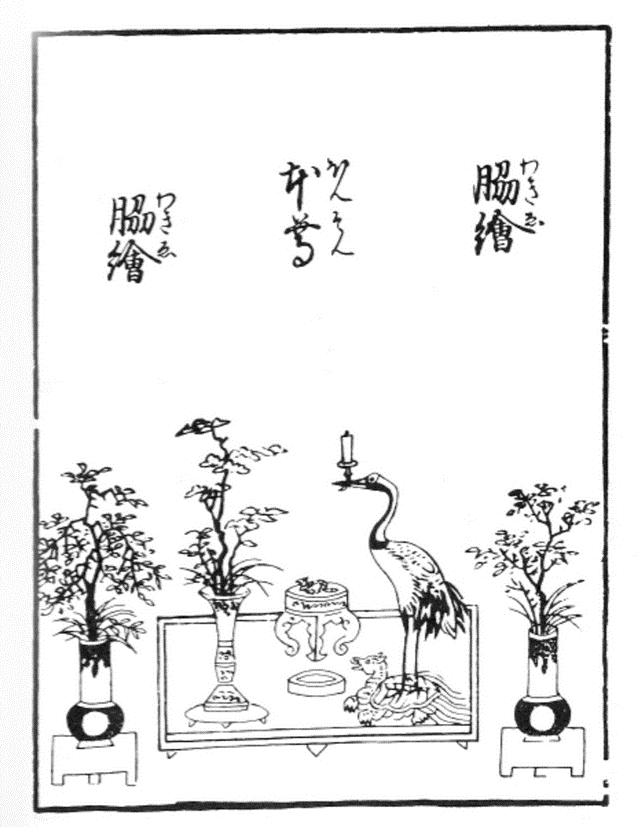Mitsu-gusoku on:
[Wikipedia]
[Google]
[Amazon]
 ''Mitsu-gusoku'' (Japanese: 三具足) in
''Mitsu-gusoku'' (Japanese: 三具足) in
 ''Mitsu-gusoku'' (Japanese: 三具足) in
''Mitsu-gusoku'' (Japanese: 三具足) in Japanese Buddhism
Buddhism has been practiced in Japan since about the 6th century CE. Japanese Buddhism () created many new Buddhist schools, and some schools are original to Japan and some are derived from Chinese Buddhist schools. Japanese Buddhism has had a ...
is a traditional arrangement of three articles, often displayed in front of a painting of the Buddha
Siddhartha Gautama, most commonly referred to as the Buddha, was a śramaṇa, wandering ascetic and religious teacher who lived in South Asia during the 6th or 5th century BCE and founded Buddhism.
According to Buddhist tradition, he was ...
or important Buddhist figures.
The articles normally consist of a censer
A censer, incense burner, perfume burner or pastille burner is a vessel made for burning incense or perfume in some solid form. They vary greatly in size, form, and material of construction, and have been in use since ancient times throughout t ...
, a candlestick
A candlestick is a device used to hold a candle in place. Candlesticks have a cup or a spike ("pricket") or both to keep the candle in place. Candlesticks are less frequently called "candleholders".
Before the proliferation of electricity, candl ...
, later in the shape of a red-crowned crane
The red-crowned crane (''Grus japonensis''), also called the Manchurian crane or Japanese crane (; the Chinese character '丹' means 'red', '頂/顶' means 'crown' and '鶴/鹤' means 'crane'), is a large East Asian crane among the rarest cran ...
, and a vase
A vase ( or ) is an open container. It can be made from a number of materials, such as ceramics, glass, non-rusting metals, such as aluminium, brass, bronze, or stainless steel. Even wood has been used to make vases, either by using tree species ...
for flower offerings. They are placed next to each other either on a tablet or a small table. This type of arrangement became popular during the Kamakura period
The is a period of Japanese history that marks the governance by the Kamakura shogunate, officially established in 1192 in Kamakura by the first ''shōgun'' Minamoto no Yoritomo after the conclusion of the Genpei War, which saw the struggle bet ...
and Nanbokucho period. The ''tatehana'' ("standing flowers") style of the ''mitsu-gusoku'' was the earliest form of flower arrangements in Japan, which was later formalised into the art of ''ikebana
is the Japanese art of flower arrangement. It is also known as . The tradition dates back to Heian period, when floral offerings were made at altars. Later, flower arrangements were instead used to adorn the (alcove) of a traditional Japan ...
''. It is mentioned that starting in the mid-15th century, the priest Ikenobō
is the oldest and largest school of ''ikebana'', the Japanese art of floral design.
It was founded in the 15th century by the Buddhist monk Senno. The school is based at the Rokkaku-dō temple in Kyoto. The name is derived from a pond (''ike' ...
Senkei of the Rokkaku-dō
The , official name , is a Buddhist temple in Kyoto, Japan, said to have been established by Prince Shōtoku. The name comes from its main hall's hexagonal shape. This temple is part of the Saigoku Kannon Pilgrimage.
History
Rokkaku-dō is beli ...
in Kyoto developed new approaches and techniques to flower arrangements, for which he received praise.
A variance exists which uses five articles, known as ''go-gusoku'' (五具足).
References
External links
Buddhist ritual implements {{japan-religion-stub